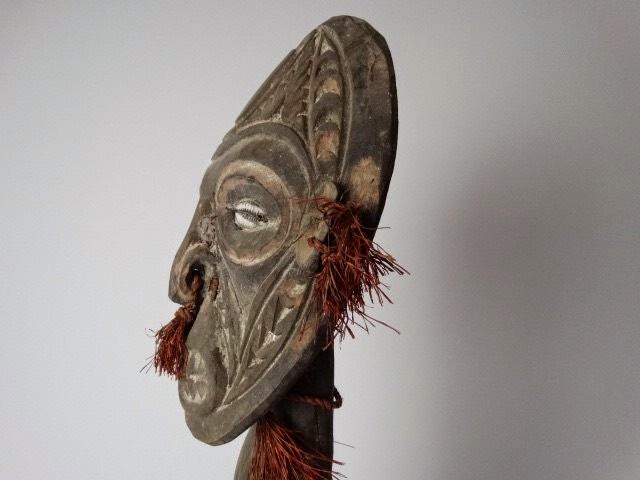This blog is a electronic museum of my collections of antiquities, ethnographic, first editions, retro pottery from the 1950's to early 1970's, shell, mineral and gemstone specimens, fossils, postcards and other wonderful things! Comments are welcome on the objects including advice which will add to my own wonderment and knowledge.
Sunday, April 19, 2015
Traditional Fierce Female Ancestor Mindibit Figure, East Sepik, Papua New Guinea circa 1950s 60cm Tall
Labels:
Ancestor Figure,
Mindimbit,
PAPUA NEW GUINEA,
Sepik River,
Wood Carving
Saturday, April 18, 2015
Australian Aboriginal Spear Point circa 2,500 years, found near the border of Western Australia and Northern Territory, Australia
Labels:
ABORIGINAL AUSTRALIA,
LITHIC INDUSTRIES,
SPEAR POINT
Friday, April 10, 2015
Australian Aboriginal Handaxe, collected in 1865 near Millicent South Australia by early settlers. Estimated age +3,000 years old. Discarded by the original maker as the tip broke off.
Labels:
ABORIGINAL AUSTRALIA,
Handaxe,
LITHIC INDUSTRIES
Australian Aboriginal Hand Axe , Port Wakefield South Australia, collected in 1860 early settlers . Estimated age + 2500 years old
Labels:
ABORIGINAL AUSTRALIA,
Handaxe,
LITHIC INDUSTRIES
Monday, April 6, 2015
Rare Stone Axe Heads: Wahgi Valley Papua New Guinea circa early 1930s.
Before the first Australian patrol to Mt Hagen in 1933, stone axes were in daily use in the Papua New Guinea Highlands and were widely traded.
Many occurrences of hard rocks suitable for axe making were exploited, but only at a few centres was the manufacture of axes carried out on a large scale. In recent times, a group of axe factories located in the Wahgi and Jimi Valleys accounted for the bulk of production and may stretch back 2,500 years.
They are no longer made (being replaced with metal trade goods) and the knowledge of how to make them has essentially been lost in the face of modern cultural influences. If owned now, they are essentially used for ceremonial purposes or as visual demonstrations of wealth and family history.
These 2 specimens were collected in the early 1970's.
Many occurrences of hard rocks suitable for axe making were exploited, but only at a few centres was the manufacture of axes carried out on a large scale. In recent times, a group of axe factories located in the Wahgi and Jimi Valleys accounted for the bulk of production and may stretch back 2,500 years.
They are no longer made (being replaced with metal trade goods) and the knowledge of how to make them has essentially been lost in the face of modern cultural influences. If owned now, they are essentially used for ceremonial purposes or as visual demonstrations of wealth and family history.
These 2 specimens were collected in the early 1970's.
Labels:
Handaxe,
LITHIC INDUSTRIES,
PAPUA NEW GUINEA,
Wahgi Valley
Subscribe to:
Comments (Atom)











